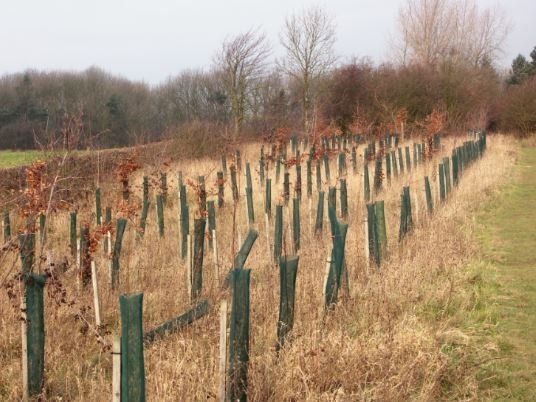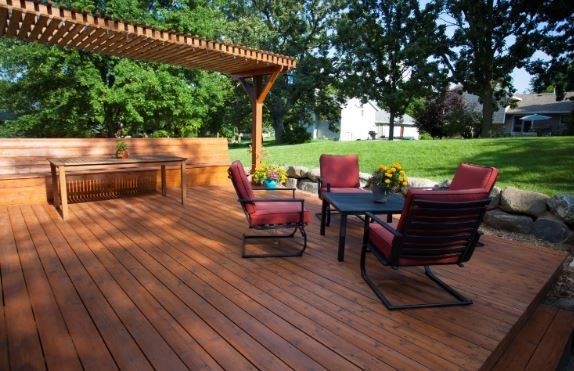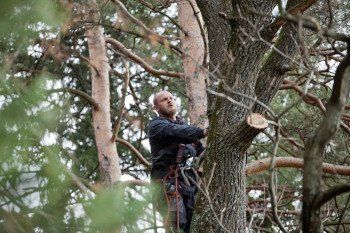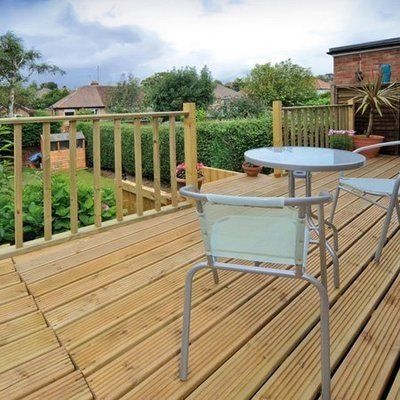Reforestation: Giving the UK Back to Nature
- By Paul Day Tree Surgery
- •
- 05 Feb, 2020
- •

When you think of the British countryside, what image first comes to mind? Do you conjure up a scene of rolling green fields, or maybe you envisage a babbling brook meandering through a quaint village? For some of us, the British countryside reminds us of our ancient forests, filled with a variety of tree species and wildlife. However, while our woodland remains a stunning and cherished addition to the British outdoors, they are sadly a mere shadow of their former selves.
Over thousands of years, British forests have been systematically chopped down for a variety of reasons, from ship-building to timber processing. This has left the UK with a measly 13% tree coverage, significantly lower than the 35% average of many EU countries.
While the statistics paint a damning picture of the state of UK forests, there has been a recent push to breath new life into our ancient woodland through the processes of reforestation and rewilding. With projects looking to restore our forests appearing up and down the country, we decided to take a closer look at what is being done.
You may be surprised but, the UK used to have large swathes of ancient woodland spanning across the whole of the British Isles, some of which grew directly after the end of the last ice age. These forests were comprised of some of the UK’s most iconic trees, including large stretches oak, hazel and birch, which were densely packed in certain regions.
Of course, as the ancient British moved towards an agricultural society, land began to be cleared to make way for farming, meaning pockets of forest were stripped away. A prime example of this can be seen on the desolate hills of Dartmoor. 12,000 years ago, the area flourished with species of trees, but as humans began to inhabit the area and clear space for hunting, the spread of peat blanket bogs began to occur, leading to the rugged landscape we have today.
Although prehistoric settlers had some part to play in deforestation, the UK was still pretty well-forested. This would soon change with the invasion of William the Conqueror after the Battle of Hastings. Soon after taking the throne, William introduced the ‘Forest Law’, which took the ancient forests away from the people and made them the property of the King.
This meant that British woodland could be used by the monarchs in any way they wish, usually for hunting, and would punish anyone who dared trespass. The law would carry on relatively unchallenged until the 17th century, with Kings and noblemen making vast amounts of money from deforestation.
While the Forest Law was finally put to an end by the mid 1600s, the British navy was still heavily reliant on wood to build its ships. So essential were our woods to the navy, the Spanish even planned to set fire to the Forest of Dean in order to put their Armada at an advantage. However, this led to UK woodland being depleted even more, especially as the navy grew in strength. Henry VIII was especially culpable when it came to deforestation, relying heavily on Irish forests for Great Britain’s wine and shipbuilding industries.
By the first World War, the UK’s forests had reached a low point never seen before. With a coverage of only 5%, British woodland had been decimated over the last 1000 years. The problem became such an issue, that in 1916, Herbert Asquith’s government carried out in-depth studies under the Acland Committee to fully understand the damage. The results were dire, with the committee pointing out that the UK desperately needed strategic timber reserves in order to both restore the environment and provide for the needs of the British people.
This wake up call was exactly what was needed to change the discourse around our woodland and would begin the long and difficult process of afforestation. A few years after the study, the Forestry Act was put into place, which in turn created the Forestry Commission. Today, the UK’s tree coverage is nearly back to levels seen over 1000 years ago, however, there is still a lot of work to be done.
As the issue of deforestation has grown more problematic over the years, more and more people and organisations are getting involved to ensure that the UK’s forests and, indeed the world’s, are being fully protected.
Over the last eight years, the UK government has planted 15 million trees in a bid to replace lost tree cover. Places like Doddington have directly benefited from these plans, with the nearby moors seeing an influx of 660,000 new trees, while cities like Manchester are committing to investing £1.5 million in new tree planting initiatives.
Rewilding is also a hot topic as of late and is a trend that is growing in popularity. The term describes the process of allowing the UK’s natural ecosystem to flourish on its own rather than using trees and other flora for commercial use. Places like Knepp Castle Estate have worked tirelessly turning its 3500 acre grounds into wild landscape filled with native plants and wild animals, including a range of ancient tree species.
Reforesting large swathes of our country poses a host of benefits both to the people and to the wider world. According to Professor Tom Crowther of Swiss university ETH Zurich, large-scale tree planting has ‘mind blowing potential’ to capture large amounts of CO2 and effectively minimise rising temperatures. This means that tree planting could be the saving grace in our fight against climate change.
Reforestation and rewilding also have the benefit of restructuring environments and ecosystems. Unfortunately deforestation damages the surrounding soil, leading to erosion and a drop in overall quality. This, of course, affects the wider ecosystem, putting a huge amount of pressure on local fauna and flora. By reforesting areas with poor quality soil, we can expect to see a healthier, more biodiverse environment as a whole.
On a more personal level, spending time amongst the trees can be an amazing experience, especially for those who may come from areas of the country with little to no tree cover. There is also a growing set of evidence which argues that walking in the woods has a host of health benefits, from disease prevention to improved mental well being. So popular have woodland walks become and the positive effects they provide, the act of ‘tree-bathing’ is growing increasingly popular throughout the UK.
Ensure your tree’s health with Paul Day Treecare
Although we may not realise it, UK forests are a huge part of our national story, which is why ensuring our ancient woodland is both restored and protected is essential. As highly-trained tree surgeons, the team at Paul Day Treecare relish the fact the UK’s tree cover is growing.
However, while planting trees is a great start, ensuring they’re healthy is equally important, which is where our team can help. Helping countless happy customers throughout the Sheffield area, our specialists have years of experience in the industry. Offering a variety of tree surgery solutions, from pollarding to felling, you can rest assured that Paul Day Treecare can help keep your trees looking great.
Our services don’t stop there though, as we also have the skills and capabilities to carry out a range of hard and soft landscaping solutions. Whether you’re looking for a well-designed garden or brand new paving, we have the skills to transform your outdoor space.
For more information on how we can help with your trees, visit our website or get in touch with our team on 01909 519 675.

Spending time in the garden has been proven to provide a range of mental health benefits. From improving the connection we have with the world to reducing stress, gardening can make us happier, healthier and more fulfilled people. Having the perfect garden to unwind in only helps to improve these benefits and, as the summer arrives, working with local gardeners can ensure your outdoor space is summer-ready.
From large-scale projects, like landscaping and patio installations, to more generalised maintenance, local gardeners can breath new life into your outdoor area for the ensuing period of parties and entertaining. To give you some inspiration, we’ve provided a few tips on how to create the perfect summer-ready garden.
Have Local Gardeners Perform Landscaping and Garden Improvements
When summer begins to peek over the horizon, it can inspire us to change our homes to accommodate living outdoors. This process may require some improvement in your garden, but investing in the below additions can create a much more habitable environment.
Paving your garden is an excellent way to create an entertainment area for the summer. If you’re lucky enough to have a large outdoor space, you can section off an area dedicated to dining and parties.
Similarly, paving is a great way to section off other areas of the garden and create a ‘zonal’ space. Using paving intelligently, local gardeners can dissect areas of your garden for different purposes. For example, you could install paving as a perimeter to your flower bed, for entertainment space and for dining.
Similarly to paving, a decked area will create a more habitable environment for friends and family to dine outdoors. By installing a decked area at the top of your garden, you can create the perfect space to utilise for summer parties and gatherings.
Local Gardeners Can Improve The Privacy of Your Garden For Summer Parties With Fencing
Creating a new entertainment space in your garden is all well and good. However, you may also need to improve the privacy of your garden at the same time. Local gardeners can provide quality fencing products to ensure that you have the privacy you want.
Particularly if you have a young family and live in a built-up area, it’s important to have adequate security. Every family wants to be able to enjoy the summer in their garden without the unease of limited privacy measures. From timber fences to bespoke solutions, there are plenty of options which ensure your garden is summer-ready.
Employ Local Gardeners To Prune and Thin Trees To Allow More Sun In
As summer approaches, your trees and bushes will begin to become more unruly. If left to their own devices, the plant life in your garden may become obstructive and can even hinder the growth of other plants. That’s why it’s always a good idea to contact local gardeners to prune and thin your trees before they get too difficult to manage.
By pruning your plants, bushes, hedges and trees in the lead up to and during summer, you’ll facilitate better growth, improve the aesthetics of your garden and increase the sunlight streaming into your outdoor space.
As well as pruning some of the larger trees in your garden, hedges and smaller bushes can also be trimmed back. Having your hedges trimmed by local gardeners will ensure they remain healthy and neat. Having a well-maintained hedge during the summer can even act as a natural alternative to a perimeter fence and can improve the biodiversity of your garden.
Prepare Your Vegetable Patch and Fruit Trees
One of the many benefits of having a garden is the ability to grow your own produce. However, doing so does require some maintenance work.
If you have a fruit tree growing in your garden, the timing of pruning can greatly impact the quality and quantity of your crop. Particularly if your fruit tree is still in its infancy, it’s important to help it grow thick branches and canopies by pruning. The best time to prune fruit trees is in early spring before any significant budding. If your fruit trees are pruned properly in the first few years, they will provide much better fruit in higher quantities.
As well as preparing your trees for fruiting, the lead up to summer can also be spent preparing your vegetable patch. The first step in the process should be preparing your soil for planting. Loosen the soil, add compost, level the soil and water it adequately.
In the spring, plants like tomatoes and peppers should be incubated indoors whilst it’s still chilly. These can be moved outside once it gets hotter. However, you can begin planting vegetables like potatoes and onions outdoors straight away. When the summer does arrive, you’ll have a healthy and happy crop ready to eat.
Some General Upkeep To Consider
As well as some of the significant improvements covered here, there is also some more generalised upkeep you can enact in the lead-up to summer.
Weeding isn’t one of the most well-loved gardening projects in the world. However, it’s a necessary evil every gardener will have to go through to ensure their garden remains healthy. The lead up to summer is the best time to tackle this problem. During spring, remove any weeds from the garden and from in between the cracks in your paving. By de-weeding, you can ensure that your plants, rather than the weeds, consume the nutrients in the soil.
At the same time as de-weeding, you should also spend some time getting rid of any pests. Using natural solutions, like crushed eggshells for slugs, you can future-proof your plant life and vegetation.
Plant Summer Plants and Tidy Flower Beds
The blossoming of flowers is one of the most satisfying experiences of summer. It signifies the changing of the seasons and begins to bring colour and warmth into your garden. During the autumn, dead leaves and twigs will have fallen down and collected in your flower beds. With summer on the horizon, now is the time to clear that up ready for summer plants. Prepare the soil of your flowerbeds, tidy the borders up and plant flowers like lilies, dahlias and others that thrive in the warmer period.
By using high-quality compost, you can greatly improve the quality of your soil and, therefore, your plants. Begin making your own compost heap months in advance to ensure it’s ready for summer. If starting during the summer, your heap should be ready for the following summer. You can then recycle much of your garden and kitchen waste to add to the compost.
Clean, Treat and Varnish Your Furniture
Finally, summer poses an opportunity to give some of your garden furniture some TLC. Dust, wash, varnish and treat your furniture to ensure it’s in the best possible condition for the summer. The spring is the best time to make these small improvements to have your garden summer-ready for friends and family.
Our Local Gardeners Provide Specialist Tree Services in Sheffield and Beyond
Do you require the services of local gardeners at your property in Sheffield and the surrounding area? If so, look no further than Paul Day Specialists. We’re experts in the industry and provide a wide range of services for both domestic and commercial clients. Whether you need a tree felling or simple hedge maintenance, we can help.
If you want to get your garden ready for the summer, with services like hedge maintenance, landscaping and pruning, one of our specialists can be on hand to help.
To find out more about our services, please feel free to contact us today. You can call us on either 01909 519 675 or 07909 743 488. Alternatively, email us at paul.daycountryside@btinternet.com.







